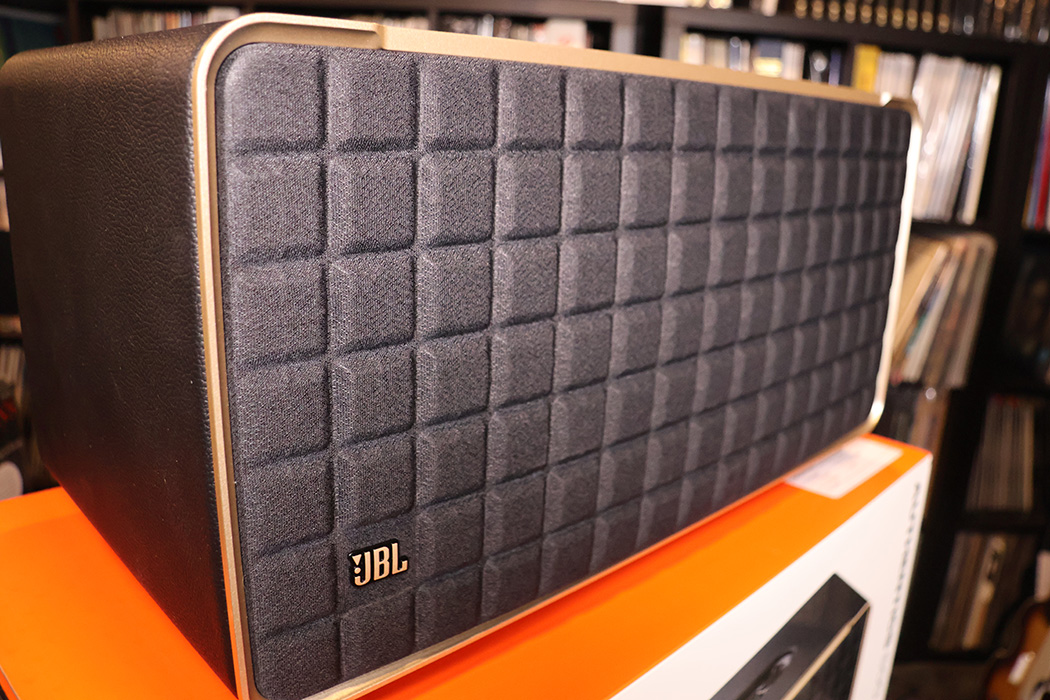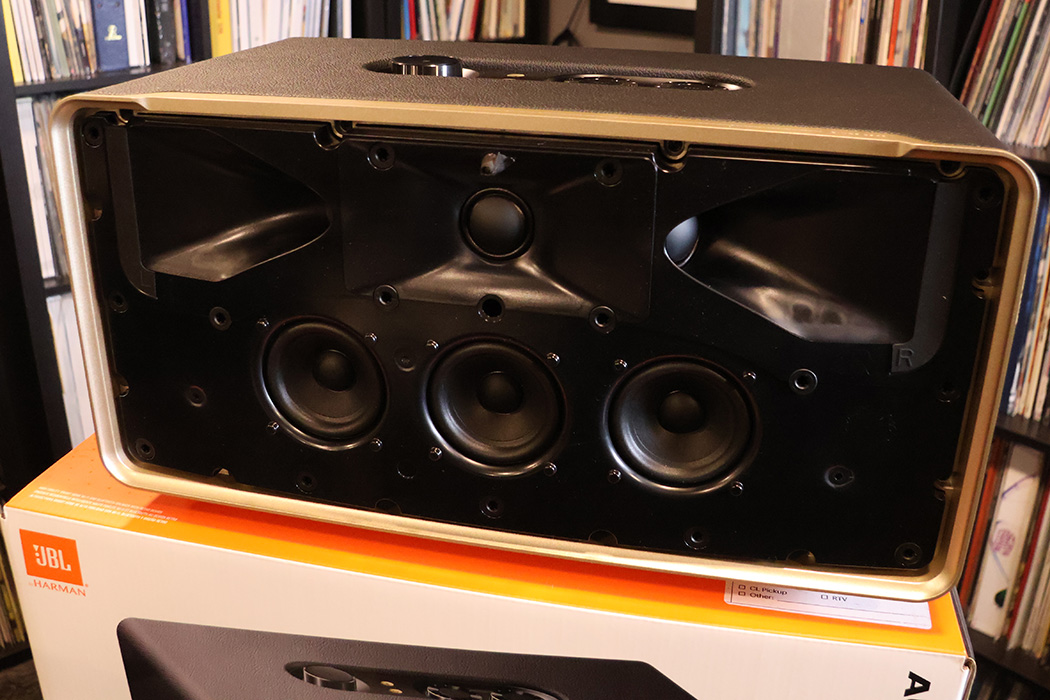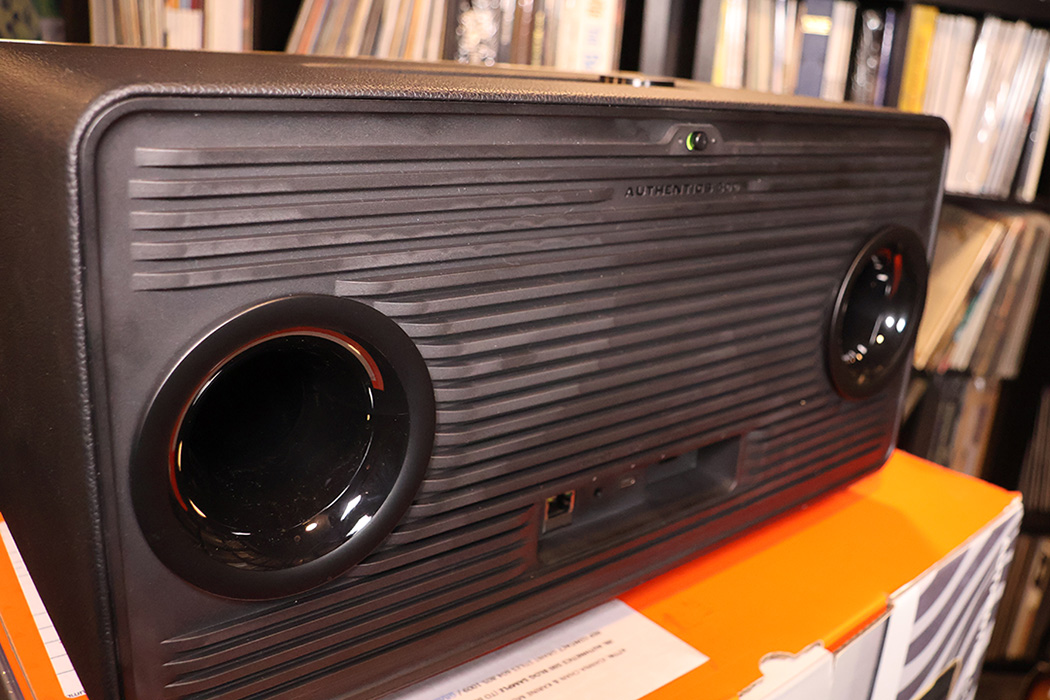
Founded way back in the late-1920s, JBL has a storied history of remarkable devices that have been loved for generations. In the 1970s and ’80s JBL released their series of L100 speakers. With their foam coverings, wood-paneled sides, and sweet sound, they quickly became one of the most iconic and beloved speakers in the history of the hi-fi hobby. With the JBL Authentics 500, the company is bringing some of that legacy aesthetic to the modern world of the powered Bluetooth speaker, promising an all-in-one solution that looks as handsome as it sounds. Does this product live up to the promise? Read on to find out!
Specifications of the JBL Authentics 500 high fidelity powered speaker
- 3x25mm Aluminum dome tweeters, 3×2.7” midrange drivers, 6.5″ subwoofer SlipStream bass port
- Dimensions: 447 x 240 x 255.7 mm
- Frequency range: 40Hz to 20kHz
- Speaker output: 270W
- Weight: 7.8kg
- Dolby Atmos compatible
- Voice Assistant integration
- Bluetooth: Version 5.3 (SBC codec)
- Wi-Fi 2.4/5GHz, Ethernet port
- Audio input: 3.5mm aux in
- USB-C input
- AirPlay, Alexa Multi-Room Music, Chrome Cast, Spotify Connect
- Google Assistant/Alexa compatibility
- JBL One App providing customization/updates (iOS and Android)
Unboxing the JBL Authentics 500
The JBL Authenics 500 speaker comes well-packaged in a colourful cardboard box, offering a far more contemporary aesthetic than what’s contained within. Once removed from its ample Styrofoam padding, the speaker feels dense and very well-constructed. Its sides are covered in a leather-like material, while the dials on top are easily accessible but feel somewhat plasticky compared to the overall premium feel. The rear features various ports, including Ethernet, a 3.5mm aux, USB-C, and a C7/C8 IEC power lead.
The front foam-looking cover is actually made of a sturdier material, doing well to both give the speaker the vibe of the 1970’s while providing a bit more protection for a device likely to sit in a high traffic area. The cover is easy to remove, revealing the multi-speaker array.
Configuring the JBL Authentics 500
Within seconds of unboxing, I was able to quickly pair my mobile device with the speaker via Bluetooth, and I could play tunes from a wide variety of sources. However, setting up the JBL One app to connect the speaker to my Wi-Fi was more challenging. After many attempts, including disconnecting my mesh network’s satellites and forcing 2.4GHz connectivity, I resorted to connect the device using its Ethernet port. After doing a firmware upgrade, everything worked perfectly smoothly. Like the inclusion of the auxiliary input, three cheers for wired connections, even for network connectivity!
Once that hiccup was taken care of, the system worked flawlessly with most of my streaming services. Chromecast and AirPlay were all tested with success, and while Spotify Connect offers a more integrated experience, other streaming services such as Tidal could connect via Chromecast rather than natively. Thanks to the features of these protocols you can even stream to multiple speakers from the same source, a welcome boon for whole home music lovers.
Despite its premium look, the Bluetooth capabilities of the speaker are limited. It only supports the basic SBC protocol, which means it lacks features like lossless audio. This makes the Wi-Fi/Ethernet connectivity all that more critical, as it not only ensures continuous music playback when moving out of Bluetooth range, but provides noticeably better sound than via transmission from your mobile device.
You can connect a variety of devices via Bluetooth, including the JBL Spinner turntable. However, I recommend using an RCA-to-3.5mm connection instead for the best sound quality. I would have preferred actual RCA inputs on the back of the JBL Authentics 500, but having the aux input is better than none.
While the manual suggests the USB-C port can be used for media playback on North American models, I was unable to get this feature to work. Given the choices of Wi-Fi/Ethernet, I’m guessing very few would even attempt this mode. The port at least provides welcome power to your mobile device, should you wish to keep it in proximity to your speaker.
The top dials control volume, play/pause, bass and treble adjustments, Bluetooth connectivity, and a “heart” button configurable via the App allows you to play back a favourite song at any time. The sides of the dials emit a faint glow. While it’s a nice aesthetic touch, I would have preferred a more tactile and/or clearer indication to provide feedback on the dial’s position within its range.
Additional EQ options are available via the JBL One App beyond the treble/bass dials. You can also use it to manage other features such as firmware updates. This means you’re likely to set a preferred sound profile for the unit, making the tone dials somewhat redundant for some users.

Sound quality of the JBL Authentics 500
The sound from the JBL Authenics 500 is powerful, but it definitely provides a more “sculpted” sound that may or may not conform with your taste. Thanks to its multi-speaker array, there’s a bit of stereo separation that’s welcome, though of course it doesn’t compare to a proper 2-channel setup with more physical space between speakers. That said, for places like kitchens or living rooms where the goal is room-filling sound rather than critical listening, there’s plenty to love about the powerful sound coming from this relatively compact source.
The specs suggest that the speaker goes down to dedicated subwoofer-like 40Hz territory. While this might be the case in an anechoic chamber, this isn’t exactly the kind of device that’s going to make you feel kickdrums deep in your chest. Still, there’s enough “oomph” here, even at relatively moderate volume, to provide appropriate amounts of impact. This is where the app-based EQ is beneficial, as one of the particularities of listening at relatively quiet volume means that both low and high frequencies are perceived to be quieter, with the mids taking centre stage. Adjusting the EQ to boost both treble and bass to create the “smiley-face” EQ curve gives a much richer sound at these volumes. For parties, you can opt for a flatter EQ curve, which is easily adjustable via the app.
My go-to bass killer remains the Hans Zimmer tracks from both Bladerunner 2049 and Dune, and the JBL managed to blast these tracks with little in the way of distortion or breakup. Depending on the surface you rest the speaker on, however, you may run into challenges, as the downfiring 6.5″ driver may in fact induce rattle. The shaking sounds is unlikely to emanate from the speaker cabinet itself, but from the surface it rests upon. Set atop a stone countertop there was little issue, but on a wooden table, the bass induced noise at higher volumes.
Midrange was fine, if not entirely involving, and the high-treble was never harsh but did feel a bit overcooked. Tweaking the EQ did tame some of these elements, but the speaker generally offers a better experience when filling a room with sound rather than for focused listening. Mono tracks shone from the single source (the Rolling Stones’ Satisfaction particularly satisfied), but even stereo showcases like The Flaming Lips’ Soft Bulletin provided some spacious fun.

Playing Dolby Atmos tracks
It’s a fun thing that the JBL Authentics 500 high fidelity powered speaker allows for playback of Atmos tracks (as of writing limited to TIDAL via Chromecast). However, I continue to worry that Dolby’s object-based surround service is being diluted when promising compatibility in standalone speakers, headphones and the like. It’s true that you’re able to play the unique mixes, with the benefit that often the Atmos version is mastered in a way that provides higher quality, less compressed sound, but it’s not as if magically you’re going to experience audio coming from phantom ceiling speakers from the JBL’s drivers.
Back-to-back comparisons of Atmos tracks from the likes of Elton John, The Beatles, and Beyonce were fun to do, but I found myself often simply choosing the stereo mix for a more pleasing experience.
So, while Atmos from single-source speaker locations remains a bit of a gimmick, it’s a fun thing to experiment with, and it’s easy enough to switch between whatever mix you choose to listen to when broadcasting from your streaming service.
Final thoughts on the JBL Authentics 500 speaker
There are high expectations from such a premium product, and for the most part, the JBL Authentics 500 high fidelity powered speaker manages to match the fine legacy its aesthetic is meant to evoke. While certain limitations such as its base-level Bluetooth disappoint, for the vast majority of users that just want a solid, easy to use speaker with powerful sound delivered from a wide variety of streaming services, you’ll be in for a treat. It’s a handsome looking beast that gives off a fun vibe while delivering decent sound, all in a relatively compact package that with use of a single power cable can help deliver a whole world of music. For those looking to upgrade from a basic portable speaker solution, or simply looking to class up the place with an echo of JBL’s past glories, this is definitely a model you should check out.





